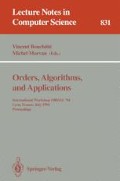Abstract
We use the quasi-ordering of substructure relations such as induced and weak subgraph, induced suborder, graph minor or subformula of a CNF formula to obtain recognition algorithms for hereditary properties that are fast on average. The ingredients needed besides inheritance are independence of the occurrence of small substructures in a random input and the existence of algorithms for recognition that are at most exponential.
Part of this work has previously been published in the first author's Ph.D. thesis, [Gus92].
Supported by the “Graduiertenkolleg Algorithmische Diskrete Mathematik”, DFG grant We 1265/2-1.
Supported by DFG grant Pr 296/2-1.
Preview
Unable to display preview. Download preview PDF.
References
Stefan Arnborg, Jens Lagergren, and Detlef Seese, Easy problems for tree-decomposable graphs, J. Algorithms 12 (1991), 308–340.
B. Bollobás, T.I. Fenner, and A.M. Frieze, An algorithm for finding hamilton paths and cycles in random graphs, in [STO85] (1985), 430–439.
L. Babai and L. Kucera, Canonical labelling of graphs in linear time, in [FOC79] (1979), 39–46.
Hans L. Bodlaender, A linear time algorithm for finding tree-decompositions of small treewidth, in [STO93] (1993).
Belá Bollobás, Random graphs, Academic Press, London, 1985.
K. J. Compton, The computational complexity of asymptotic problems. I: Partial orders, Inform. and Complexity 78 (1988), 103–123.
M.E. Dyer and A.M. Frieze, The solution of some random NP-hard problems in polynomial expected time, J. Algorithms 10 (1989), 451–489.
P. Erdős and A. Rényi, On the evolution of random graphs, Madyar Tnd. Akad. Mat. Kut. Int. Kőzl. 6 (1960), 17–61.
Michael R. Fellows, The Robertson-Seymour theorems: a survey of applications, see [GA89], 1989, pp. 1–18.
Michael R. Fellows and Michael A. Langston, Nonconstructive advances in polynomial-time complexity, Inform. Process. Lett. (1985).
Michael R. Fellows and Michael A. Langston, Nonconstructive tools for proving polynomial-time decidability, J. Assoc. Comput. Mach. 35 (1988), no. 3, 727–739.
Michael R. Fellows and Michael A. Langston, On well-partial-order theory and its application to combinatorial problems of VLSI design, SIAM J. Disc. Math. 5 (1992), no. 1, 117–126.
20th Annual Symposion On Foundations of Computer Science, IEEE, The Institute of Electrical and Electronics Engineers, IEEE Computer Society Press, 1979.
John Franco and Marvin Paull, Probabilistic analysis of the Dams Putnam procedure for solving the satisfiability problem, Discrete Appl. Math. 5 (1983), 77–87.
A.M. Frieze, Probabilistic analysis of graph algorithms, Computing 7 (1990), 209–233.
Graphs and Algorithms (R. B. Richter, ed.), American Math. Soc., Contemp. Math., 89, 1989, Proceedings of the AMS-IMS-SIAM joint Summer Research Conference 1987.
Michael R. Garey and David S. Johnson, Computers and Intractability, W. H. Freeman and Company, New York, 1979.
Martin C. Golumbic, Algorithmic graph theory and perfect graphs, Academic Press, London, New York, 1980.
A. Goldberg, P. Purdom, and C. Brown, Average time analysis of simplified Davis-Putnam procedures, Inform. Process. Lett. 15 (1982), 72–75, Corrigendum, Inform. Process. Lett. 16 (1982), 213.
Jens Gustedt, Algorithmic aspects of ordered structures, Ph.D. thesis, Technische Universität Berlin, 1992.
T. H. Hu, C. Y. Tang, and R. C. T. Lee, An average case analysts of Monien and Speckmeyer's mechanical theorem proving algorithm, in [ISA91] (1991), 116–126.
ISA '91 Algorithms (Wen-Lian Hsu and R.C.T. Lee, eds.), Springer-Verlag, 1991, LNCS 557, Proceedings of the 2nd International Symposion on Algorithms, Taipei, Republic of China.
Kazuo Iwama, CNF satisfiability test by counting and polynomial average time, SIAM J. Comput. 18 (1989), no. 2, 385–391.
Svante Janson, Thomasz Luczak, and Andrezj Ruciński, An exponential bound for the probability of nonexistence of a specified subgraph in a random graph, Random Graphs '87 (M. Karoński, J. Jaworski, and A. Ruciński, eds.), John Wiley & Sons, New York, 1990, pp. 73–87.
David S. Johnson, The NP-completeness column: An ongoing guide, “Solving NP-hard Problems Quickly (On Average)”, J. Algorithms 5 (1984), 284–299.
Rolf H. Möhring, Graph problems related to gate matrix layout and PLA folding, Computational Graph Theory (Wien) (G. Tinhofer et al., eds.), Springer-Verlag, Wien, 1990, pp. 17–52.
Hans Jürgen Prömel and Angelika Steger, Coloring clique-free graphs in linear expected time, Random Structures and Algorithms 3 (1992), 374–402.
Hans Jürgen Prömel and Angelika Steger, Excluding induced subgraphs III: A general asymtotic, Random Structures and Algorithms 3 (1992), no. 1, 19–31.
Neil Robertson and Paul Seymour, Disjoint paths — a survey, SIAM J. Algebraic Discrete Methods 6 (1985), no. 2, 300–305.
Neil Robertson and Paul Seymour, Graph minors — a survey, Surveys in Combinatorics (Glasgow 1985) (I. Anderson, ed.), Cambridge Univ. Press, Cambridge-New York, 1985, pp. 153–171.
Proceedings of the Seventeenth Anual ACM Symposion on Theory of Computing, ACM, Assoc. for Comp. Machinery, 1985.
Proceedings of the Twenty Fifth Anual ACM Symposion on Theory of Computing, ACM, Assoc. for Comp. Machinery, 1993.
A.G. Thomason, An extremal function for contractions of graphs, Math. Proc. Cambridge Philos. Soc. 95 (1984), 261–265.
H. S. Wilf, Backtrack: an O(1) texpected time algorithm for the graph coloring problem, Inform. Process. Lett. 18 (1984), 119–121.
Peter Winkler, Random orders, Order 1 (1985), 317–331.
Peter Winkler, A counterexample in the theory of random orders, Order 5 (1989), 363–368.
Author information
Authors and Affiliations
Editor information
Rights and permissions
Copyright information
© 1994 Springer-Verlag Berlin Heidelberg
About this paper
Cite this paper
Gustedt, J., Steger, A. (1994). Testing hereditary properties efficiently on average. In: Bouchitté, V., Morvan, M. (eds) Orders, Algorithms, and Applications. ORDAL 1994. Lecture Notes in Computer Science, vol 831. Springer, Berlin, Heidelberg. https://doi.org/10.1007/BFb0019429
Download citation
DOI: https://doi.org/10.1007/BFb0019429
Published:
Publisher Name: Springer, Berlin, Heidelberg
Print ISBN: 978-3-540-58274-8
Online ISBN: 978-3-540-48597-1
eBook Packages: Springer Book Archive

